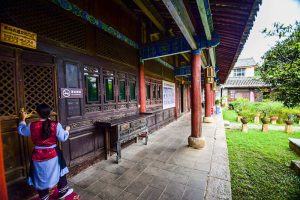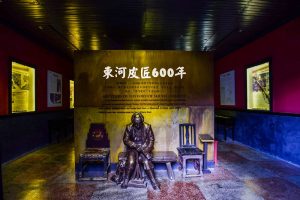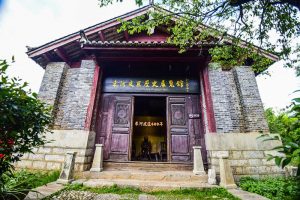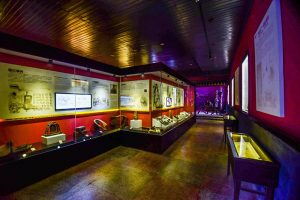
Lijiang Ancient Tea Horse Road Museum

Chinese Name: 茶马古道博物馆
English Name: Lijiang Ancient Tea Horse Road Museum
Chinese Pinying: Cha Ma Gu Dao Bo Wu Guan
Keywords: Ancient Tea Horse Road culture, Pu-erh tea culture, local custom of Shuhe town
Location: Located on Zhonghe Road, Shuhe Ancient Town, Lijiang City, the northwest of Yunnan Province
Admission Fee: free
Opening Hours: 9:00-18:00
Traveling Hours: 0.5-1 hour
Traveling Seasons: all seasons
About Lijiang Ancient Tea Horse Road Museum
Lijiang Tea Horse Road Museum, also known as Dajue Palace (大觉宫), is a precious ancient building and a component of the “Shuhe Academy” complex, built by the Mu clan(木氏土司) during the Ming Dynasty. The museum within this structure is dedicated to the culture of the Tea Horse Road, local customs of Shuhe, and Pu’er tea culture. It is the first museum in China specifically focused on researching and showcasing the history and culture of the Tea Horse Road. Additionally, it is the first institution in Lijiang City devoted to the research, promotion, and dissemination of Pu’er tea culture.
What to see in Lijiang Ancient Tea Horse Road Museum
Architectural Composition
Like the Baisha murals, the six fresco paintings in the museum are the only examples of the Ming dynasty mural paintings in Yunnan Province. These paintings are listed as provincial cultural relics. The now overall protected surrounding buildings are the teaching buildings of Shuhe Primary School during the period of Republic of China. Here, tourists can have a deeper understanding of the history and culture of the tea and horse road.
The museum is divided into five exhibition areas, including the Preamble Hall, the Murals Exhibition Hall, and History Hall one, History Hall Two, Shuhe Living Hall, and Shuhe Cobbler men Hall. They all demonstrate the long history and profound culture of this area to the tourists.
About the Preamble Hall

The Tea Horse Road Museum is part of the “Shuhe Academy” complex established by the Mu clan during the Ming Dynasty. It contains six murals, similar to the Baisha murals, which are considered exemplary Ming Dynasty murals in Yunnan and are listed as provincial-level cultural relics. Surrounding buildings were once the teaching buildings of Shuhe Primary School during the Republic of China era and are now fully preserved, making the museum a key location for visitors to learn about the history and culture of the Tea Horse Road.
The museum is divided into five exhibition areas: the Prologue Hall, the Mural Exhibition Hall, Historical Hall 1, Historical Hall 2, Shuhe Living Hall, and Shuhe Leatherworker Hall. These sections provide visitors with a comprehensive display of the region’s long history and culture:
- Prologue Hall:
- In 641 AD, the Tibetan King Songtsen Gampo successfully married a Tang dynasty princess, Princess Wencheng, who brought advanced production methods and tea-drinking customs to Tibet.
- During the Tianbao period of Emperor Xuanzong of Tang, tensions arose between the Tang dynasty and Tibet, leading to a ban on tea entering Tibet. In response, the Tibetan Empire used the Yunnan-Tibet route established in earlier years to resolve the tea crisis. This marked the entry of Yunnan tea into Tibet, eventually spreading to India, West Asia, and Europe.
- From the Song and Yuan dynasties to the Ming and Qing dynasties, the Tea Horse trade expanded due to political, military, and economic factors, making the Tea Horse Road a crucial link between the various ethnic groups in southwestern China and the central imperial government. During the Anti-Japanese War, the ancient Tea Horse Road became the only international trade route, with large amounts of strategic materials passing through it to support the war effort and promote the development of towns along the route.
- Lijiang, located at a strategic point on the Yunnan-Tibet route, became an essential gateway on the Tea Horse Road. The cultural and religious ties between the Naxi and Tibetan people made the Naxi an important participant in the Tea Horse trade. This route also attracted explorers to Lijiang and the Three Parallel Rivers region, introducing the area’s biodiversity and cultural diversity to the world. Lijiang Old Town (including the Shuhe residential complex) was listed as a UNESCO World Heritage site in December 1997. The Three Parallel Rivers region was declared a World Natural Heritage site in July 2003, and the Naxi Dongba ancient manuscripts were included in the Memory of the World Register in August 2003.
- The Tea Horse Road, one of the oldest trade routes in mainland China, is comparable to the Northern and Southern Silk Roads. Its significant impact and influence require further study and understanding.
- Mural Exhibition Hall:
- The Dajue Palace murals are an integral part of the Lijiang mural collection. These murals, created over more than 300 years from the 18th year of the Hongwu period of the Ming Dynasty (1385 AD) to the eighth year of the Qianlong period of the Qing Dynasty (1743 AD), are spread across various locations in and around Lijiang Old Town, including Juexian Temple, Hufa Hall, Wande Palace, Shanbi Yard, Guiyi Hall, Guangbi Building, Hantan Temple, Dajue Palace, Dabaoji Palace, Liuli Hall, Dading Pavilion, Fuguo Temple, and Xuesong Temple, totaling over 200 panels. Today, only 50 panels remain, covering a total area of 154.57 square meters. The Dajue Palace in Shuhe Village, located 4 kilometers northwest of Lijiang Old Town, has six murals dating back to the Wanli period of the Ming Dynasty during the reign of Mu Zeng. The style of these murals is similar to those in Dabaoji Palace and is considered slightly later works.
- Historical Halls:
- Significant historical events that occurred along the thousand-year-old Tea Horse Road are highlighted in the museum, showcasing their profound influence on later history. The museum covers events such as the Tibetan southward expansion, the Tianbao War, Yunnan tea entering Tibet, the Tea Horse market, and the Yuan dynasty’s strategic use of leather sacks.
Additional exhibition areas, such as Historical Hall 2, Shuhe Living Hall, and Shuhe Leatherworker Hall, are still under construction.

History of Development
The establishment of the “Shenchuan Dudu Fu” in Lijiang during the Tibetan southward expansion marked the beginning of the Tea Horse Road. Emperor Xuanzong’s ban on tea entering Tibet facilitated the trade of Yunnan tea into Tibet. The military needs of the Song dynasty stimulated the prosperity of the Tea Horse market. From the Yuan and Ming dynasties to the modern era, the Tea Horse Road became a vital link for economic and cultural exchange between Yunnan, Tibet, and Sichuan.
The Tea Horse Road, originating in southern Yunnan and passing through Dali, Lijiang, Diqing, and Lhasa before reaching India, traverses regions rich in cultural diversity, such as the Three Parallel Rivers and Shangri-La. It is a significant trade route connecting China with South Asia.
The Lijiang Tea Horse Road Museum consists of eight sections: the Prologue Hall, Historical Hall 1, Historical Hall 2, Shuhe Hall, Leatherworker Hall, Tea Horse Customs Hall, Tea Art Hall, and Information Resource Center. The museum systematically introduces the origins, routes, and major historical events of the Tea Horse Road, serving as an important window for understanding the history and culture of this ancient trade route.
How to get to Lijiang Ancient Tea Horse Road Museum from Lijiang
First of all, People need to go to Shuhe Ancient Town, for Lijiang Ancient Tea Horse Road Museum is there.
1. Daily shuttle buses depart from Lijiang Ancient City to Shuhe Ancient Town, a great convenience for travelers.
2. Visitor also can take a taxi there, which takes about 20 minutes, or they can bike, which takes about 1.5 hours.
● Take bus no. 11, and get off at Shuhe Crossing. Then turn left and walk around 10 minutes.
● Take bus no. 6, and get off at Shuhe Shangcun Station.
●Take a taxi. The fare is around CNY 20.
● Ride a bicycle to reach there. It takes around 40 minutes from Lijiang Old Town.
‣ Best Time to Visit
● The peak period for visiting Lijiang Ancient Tea Horse Road Museum is from May to October. Actually, It is worth visiting during any season, so if you do not want to experience a crowded scene, avoiding that period might be a good option.
Recommended Tour with
1 Day Lijiang Cycling Tour from Lijiang Old Town to Shuhe, Baisha and Yuhu Village

Shuhe Ancient Town Accommodation
Shuhe Ancient Town is an important constituent part of Lijiang Ancient City, a world cultural heritage site in China. There are many high-quality hotels in the old town although the quantity is not as good as that of Lijiang Old Town. Shuhe old town is much more tranquil than Lijiang Old Town, less crowded and less noisy, and the air is very good at the foot of the mountain. Follow Yunnan Exploration to discover the best hotels in Shuhe Old Town such as Banyan Tree Lijiang.
1.Lijiang Conifer Lishui Yangguang Hotel(康年丽水阳光酒店)
At Lijiang Conifer Lishui Yangguang Hotel, the excellent service and superior facilities make for an unforgettable stay. The hotel offers access to a vast array of services, including 24-hour room service, casino, facilities for disabled guests, Wi-Fi in public areas, car park.
Add: Entrance of Shu He Ancient Town, Suburbs, Lijiang, China
2. Lijiang E-Outfitting Boutique Hotel(丽江首译精品客栈)
Lijiang E-Outfitting Boutique Hotel also offers many facilities to enrich your stay in Lijiang. While lodging at this wonderful property, guests can enjoy 24-hour room service, free Wi-Fi in all rooms, 24-hour front desk, express check-in/check-out, luggage storage.
Add: No.35 Qingyun Village, Shuhe Old Town, Lijiang, China
3.Banyan Tree Lijiang(丽江悦榕庄)
Located in Shuhe Old Town, Lijiang, Banyan Tree offers a relaxing retreat away from the city. Surrounded by fresh mountain air and green landscapes, the property features luxurious accommodations with traditional Naxi-style décor and free Wi-Fi in all areas.
Add: No.1, Yuerong Road, Shuhe Old Town, Lijiang, China
4.The Bivou Lijiang(佖屋酒店)
Only a short 1-minute stroll from Shuhe Ancient Town, The Bivou features accommodations in local and modern styles combined together. Blending in by making use of the barbecue facilities, lazing in soothing massage, going horse riding or enjoying a fun time with your children at kids’ club seems like a nice getaway. Free Wi-Fi is available in all areas.
Add: 16 Zhonghe Cun, Shuhe Old Town, Lijiang, China
5.K2 International Youth Hostel(束河K2国际青年旅舍)
K2 International Youth Hostel Lijiang offers a comfortable setting while in Lijiang. It also provides luggage storage, a 24-hour reception and wireless internet. Lijiang Sanyi Airport is a 55-minute drive from K2 International Youth Hostel Lijiang. Black Dragon Pool and the Dongba Culture Museum are just a short drive from the hostel.
Add: No. 1 Guailiu Lane Kangpu Road, Shuhe Old Town, Lijiang, China

Shuhe Ancient Town Travel Tips
Altitude Sickness
The altitude is about 2,400 meters or about 7,800 feet. Some people may get some altitude sickness. So take it easy the first day or two.
What to Pack
Travel light when strolling in the old town. Bring a camera with you that you can take photos along the way. Sunlight is very strong in Lijiang, wear sun protection such as hats, sunglasses and use sun block, etc.
Entertainment
Do not miss the bars in Lijang. They are a part of life. The bars in Shuhe Old Town is more quieter than Lijiang old town.
Dining
In Shuhe Old Town, some small restaurants are also surprising. The famous local dishes includes Chickpeas Bean Jelly, Lijiang Salted Pork Ribs, Naxi barbecue and other Lijiang delicacies.
Hotels
Just like Lijiang Old Town, Shuhe Old Town has many high-qualify hotels or hostels for you to choose from. The recommended hotels are Banyan Tree Lijiang, Lijiang Conifer Lishui Yangguang Hotel, etc.
Other Tips
1. If you plan to travel to Lijiang during the peak tourist season (Spring Festival, May Day, Summer holiday, and National Day holiday), be sure to reserve a room in advance.
2. There used to have carriages getting in and out of this town, so be careful.
3. It is best to wear cloth shoes or sneakers when walking in the old town, because they are all slabstone path, it is easy to twist your feet with high heels.
4.Take rain gear when you visit in the rainy season, and the slabstone path are slippery after the rain. Pay attention to that.
Attraction Travel Tips:
Traveling Hours: 0.5-1 hour
Traveling Seasons: all seasons
Opening Hours: 9:00-18:00

 7 Days GolfingTour
7 Days GolfingTour
 8 Days Group Tour
8 Days Group Tour
 8 Days Yunnan Tour
8 Days Yunnan Tour
 7 Days Shangri La Hiking
7 Days Shangri La Hiking
 11 Days Yunnan Tour
11 Days Yunnan Tour
 6 Days Yuanyang Terraces
6 Days Yuanyang Terraces
 11 Days Yunnan Tour
11 Days Yunnan Tour
 8 Days South Yunnan
8 Days South Yunnan
 7 Days Tea Tour
7 Days Tea Tour
 8 Days Muslim Tour
8 Days Muslim Tour
 12 Days Self-Driving
12 Days Self-Driving
 4 Days Haba Climbing
4 Days Haba Climbing
 Tiger Leaping Gorge
Tiger Leaping Gorge
 Stone Forest
Stone Forest
 Yunnan-Tibet
Yunnan-Tibet
 Hani Rice Terraces
Hani Rice Terraces
 Kunming
Kunming
 Lijiang
Lijiang
 Shangri-la
Shangri-la
 Dali
Dali
 XishuangBanna
XishuangBanna
 Honghe
Honghe
 Kunming
Kunming
 Lijiang
Lijiang
 Shangri-la
Shangri-la
 Yuanyang Rice Terraces
Yuanyang Rice Terraces
 Nujiang
Nujiang
 XishuangBanna
XishuangBanna
 Spring City Golf
Spring City Golf
 Snow Mountain Golf
Snow Mountain Golf
 Stone Mountain Golf
Stone Mountain Golf














